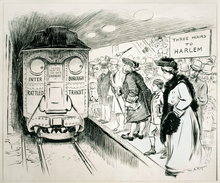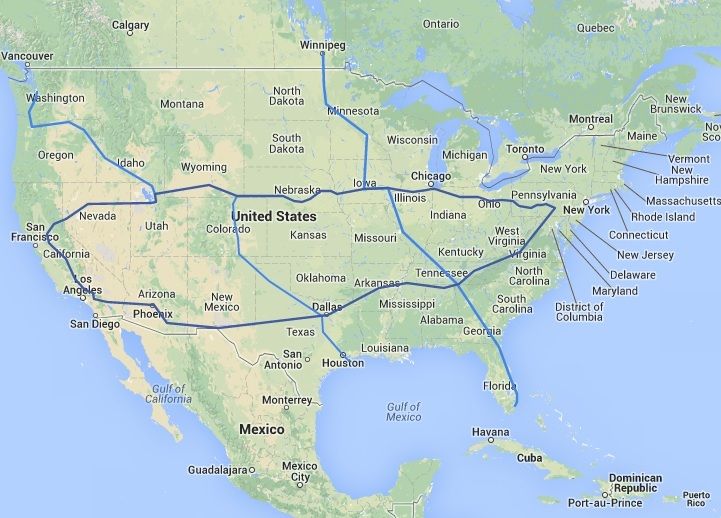This is your morning Open Thread. Pour your favorite beverage and review the past and comment on the future.
Find the past “On This Day in History” here.
October 27 is the 300th day of the year (301st in leap years) in the Gregorian calendar. There are 65 days remaining until the end of the year.
On this day in 1904, the New York Subway opens.
 While London boasts the world’s oldest underground train network (opened in 1863) and Boston built the first subway in the United States in 1897, the New York City subway soon became the largest American system. The first line, operated by the Interborough Rapid Transit Company (IRT), traveled 9.1 miles through 28 stations. Running from City Hall in lower Manhattan to Grand Central Terminal in midtown, and then heading west along 42nd Street to Times Square, the line finished by zipping north, all the way to 145th Street and Broadway in Harlem. On opening day, Mayor McClellan so enjoyed his stint as engineer that he stayed at the controls all the way from City Hall to 103rd Street.
While London boasts the world’s oldest underground train network (opened in 1863) and Boston built the first subway in the United States in 1897, the New York City subway soon became the largest American system. The first line, operated by the Interborough Rapid Transit Company (IRT), traveled 9.1 miles through 28 stations. Running from City Hall in lower Manhattan to Grand Central Terminal in midtown, and then heading west along 42nd Street to Times Square, the line finished by zipping north, all the way to 145th Street and Broadway in Harlem. On opening day, Mayor McClellan so enjoyed his stint as engineer that he stayed at the controls all the way from City Hall to 103rd Street.
History
A demonstration for an underground transit system in New York City was first built by Alfred Ely Beach in 1869. His Beach Pneumatic Transit only extended 312 feet (95 m) under Broadway in Lower Manhattan and exhibited his idea for a subway propelled by pneumatic tube technology. The tunnel was never extended for political and financial reasons, although extensions had been planned to take the tunnel southward to The Battery and northwards towards the Harlem River. The Beach subway was demolished when the BMT Broadway Line was built in the 1910s; thus, it was not integrated into the New York City Subway system.
The first underground line of the subway opened on October 27, 1904, almost 35 years after the opening of the first elevated line in New York City, which became the Ninth Avenue Line. The heavy 1888 snowstorm helped to demonstrate the benefits of an underground transportation system. The oldest structure still in use opened in 1885 as part of the BMT Lexington Avenue Line, and is now part of the BMT Jamaica Line in Brooklyn. The oldest right-of-way, that of the BMT West End Line, was in use in 1863 as a steam railroad called the Brooklyn, Bath and Coney Island Rail Road. The Staten Island Railway, which opened in 1860, currently uses R44 subway cars, but it has no links to the rest of the system and is not usually considered part of the subway proper.
By the time the first subway opened, the lines had been consolidated into two privately owned systems, the Brooklyn Rapid Transit Company (BRT, later Brooklyn-Manhattan Transit Corporation, BMT) and the Interborough Rapid Transit Company (IRT). The city was closely involved: all lines built for the IRT and most other lines built or improved for the BRT after 1913 were built by the city and leased to the companies. The first line of the city-owned and operated Independent Subway System (IND) opened in 1932; this system was intended to compete with the private systems and allow some of the elevated railways to be torn down, but was kept within the core of the City due to the low amount of startup capital provided to the municipal Board Of Transportation, the later MTA, by the state.[3] This required it to be run ‘at cost’, necessitating fares up to double the five cent fare popular at the time.
In 1940, the two private systems were bought by the city; some elevated lines closed immediately, and others closed soon after. Integration was slow, but several connections were built between the IND and BMT, and now operate as one division called the B Division. Since the IRT tunnel segments are too small and stations too narrow to accommodate B Division cars, and contain curves too sharp for B Division cars, the IRT remains its own division, A Division.
The New York City Transit Authority, a public authority presided by New York City, was created in 1953 to take over subway, bus, and streetcar operations from the city, and was placed under control of the state-level Metropolitan Transportation Authority in 1968.
In 1934, transit workers of the BRT, IRT, and IND founded the Transport Workers Union of America, organized as Local 100. Local 100 remains the largest and most influential local of the labor union. Since the union’s founding, there have been three union strikes. In 1966, transit workers went on strike for 12 days, and again in 1980 for 11 days. On December 20, 2005, transit workers again went on strike over disputes with MTA regarding salary, pensions, retirement age, and health insurance costs. That strike lasted just under three days.

 The
The  While London boasts the world’s oldest underground train network (opened in 1863) and Boston built the first subway in the United States in 1897, the New York City subway soon became the largest American system. The first line, operated by the Interborough Rapid Transit Company (IRT), traveled 9.1 miles through 28 stations. Running from City Hall in lower Manhattan to Grand Central Terminal in midtown, and then heading west along 42nd Street to Times Square, the line finished by zipping north, all the way to 145th Street and Broadway in Harlem. On opening day, Mayor McClellan so enjoyed his stint as engineer that he stayed at the controls all the way from City Hall to 103rd Street.
While London boasts the world’s oldest underground train network (opened in 1863) and Boston built the first subway in the United States in 1897, the New York City subway soon became the largest American system. The first line, operated by the Interborough Rapid Transit Company (IRT), traveled 9.1 miles through 28 stations. Running from City Hall in lower Manhattan to Grand Central Terminal in midtown, and then heading west along 42nd Street to Times Square, the line finished by zipping north, all the way to 145th Street and Broadway in Harlem. On opening day, Mayor McClellan so enjoyed his stint as engineer that he stayed at the controls all the way from City Hall to 103rd Street.
Recent Comments